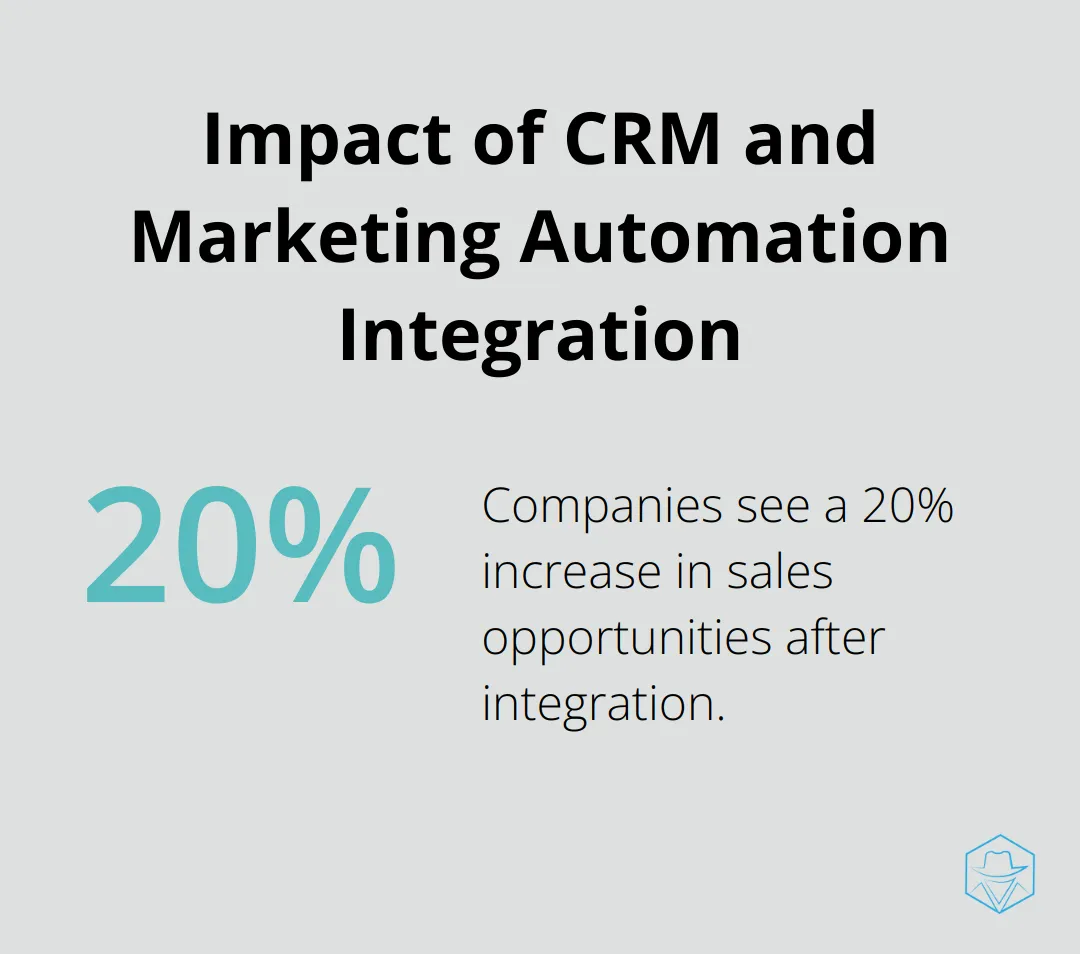Salesforce and Marketing Automation: Perfect Synergy

At Drop Cowboy, we’ve seen firsthand how the right tools can transform a business. Salesforce and marketing automation are two powerhouses that, when combined, create an unstoppable force in the world of sales and marketing.
This dynamic duo streamlines processes, enhances customer relationships, and drives revenue growth like never before. In this post, we’ll explore how Salesforce and marketing automation work together to supercharge your business operations.
What Are Salesforce and Marketing Automation?
Salesforce CRM: A Powerful Platform
Salesforce CRM is a cloud-based customer relationship management platform that helps businesses manage their customer interactions, sales processes, and data. It centralizes customer information, tracks sales opportunities, and provides insights to improve customer relationships. This powerful tool serves as the backbone for many companies’ sales and customer service operations.
Marketing Automation: Streamlining Campaigns
Marketing automation technology streamlines and automates marketing tasks and workflows. It helps businesses nurture leads, personalize communications, and measure campaign effectiveness. With marketing automation, companies can create targeted campaigns, track customer behavior, and optimize their marketing efforts based on data-driven insights. This technology transforms how businesses approach their marketing strategies.
The Synergy of Integration
Integrating Salesforce CRM with marketing automation creates a synergy that amplifies the strengths of both systems. This integration allows for seamless data flow between sales and marketing teams, ensuring that everyone has access to the most up-to-date customer information. A study by Forrester Research found that companies that integrate their CRM and marketing automation systems see a 20% increase in sales opportunities. This boost in performance comes from the ability to create more targeted and personalized marketing campaigns based on rich customer data stored in Salesforce.

Real-World Impact
The integration of Salesforce and marketing automation has transformed business operations across various industries. For example, an e-commerce company saw a 35% increase in conversion rates after integrating their Salesforce CRM with marketing automation features. They created highly targeted SMS campaigns based on customer purchase history and browsing behavior tracked in Salesforce, leading to improved engagement and sales.
Selecting the Right Tools
When selecting a marketing automation platform to integrate with Salesforce, compatibility and ease of use are key factors. Look for platforms that offer native integrations with Salesforce to ensure smooth data synchronization. Additionally, consider tools that align with your specific business needs and goals. While many options exist, it’s important to choose a solution that offers seamless integration and aligns with your business objectives (such as improved customer engagement or higher conversion rates).
Maximizing Return on Investment
To get the most out of integrating Salesforce and marketing automation, businesses should focus on aligning their sales and marketing teams. This alignment ensures that both teams work towards the same goals and use the integrated system effectively. A report by Aberdeen Group found that companies with strong sales and marketing alignment achieve a 20% annual growth rate, compared to a 4% decline in revenue for companies with poor alignment. This stark difference highlights the importance of not just integrating systems, but also aligning teams and processes.

As we move forward, let’s explore the key benefits that businesses can expect when they successfully integrate Salesforce with their marketing automation efforts.
Unlocking the Power of Integration
Supercharging Lead Management
The integration of Salesforce with marketing automation tools creates a powerhouse of capabilities that revolutionizes business operations. Companies that use integrated CRM and marketing automation systems experience a 14.5% increase in sales productivity (Nucleus Research). This boost stems from the ability to automatically score and qualify leads based on their interactions with marketing campaigns. For instance, a lead who opens multiple emails and visits high-value pages on a website can receive an automatic flag as a hot prospect in Salesforce, prompting immediate follow-up from the sales team.

Precision Targeting for Maximum Impact
The combination of Salesforce and marketing automation allows for unprecedented levels of customer segmentation and targeting. A report from Ascend2 found that 51% of marketers consider improving the quality of lead data their most important objective for using marketing automation integrated with CRM. This integration enables the creation of hyper-targeted campaigns based on a wealth of data points stored in Salesforce (such as past purchases, engagement history, and demographic information). An e-commerce company could automatically trigger a personalized email campaign to customers who have abandoned their shopping carts, offering a discount on the specific items they were considering.
Streamlining Workflows for Peak Efficiency
One of the most significant benefits of this integration is the streamlining of workflows across sales and marketing teams. Businesses that use marketing automation to nurture prospects experience a 451% increase in qualified leads (Marketo). This dramatic improvement results from the automation of repetitive tasks and the creation of seamless handoffs between marketing and sales. When a lead reaches a certain score threshold in the marketing automation system, it can receive an automatic assignment to a sales rep in Salesforce, complete with a detailed history of the lead’s interactions with the company.
Enhanced Data Insights and Reporting
The integration of Salesforce and marketing automation provides a comprehensive view of customer interactions and campaign performance. This unified data ecosystem allows for more accurate reporting and deeper insights into customer behavior. Marketing teams can track the entire customer journey from initial contact to final purchase, while sales teams gain visibility into the effectiveness of marketing efforts. These insights (derived from both systems) enable data-driven decision-making and continuous optimization of marketing and sales strategies.
Improved Customer Experience
The synergy between Salesforce and marketing automation ultimately leads to an improved customer experience. With access to detailed customer data and behavior patterns, businesses can deliver more personalized and timely communications. This level of personalization fosters stronger customer relationships and increases the likelihood of conversions and repeat business. As we move forward, we’ll explore the best practices for successfully implementing this powerful integration and maximizing its benefits for your business.
How to Maximize Salesforce and Marketing Automation Integration
Select the Right Marketing Automation Platform
The selection of a marketing automation platform that integrates seamlessly with Salesforce is essential. We recommend platforms with native Salesforce connectors to ensure smooth data flow. Evaluate solutions like Marketo, Pardot, or HubSpot (which offer robust Salesforce integrations) against your specific business needs. If SMS marketing is a priority, ensure the platform supports this functionality or can integrate with specialized tools like Drop Cowboy.
Align Sales and Marketing Teams
Successful integration requires more than technology-it demands alignment between sales and marketing teams. Establish shared goals and KPIs. Create a service level agreement (SLA) that defines lead qualification, scoring, and handoff processes between teams. Schedule regular cross-functional meetings to maintain alignment and address issues promptly. Companies with strong sales and marketing alignment achieve 38% higher sales win rates (MarketingProfs).
Ensure Data Quality
Clean, standardized data forms the foundation of effective integration. Implement rigorous data cleansing processes to eliminate duplicates, standardize formats, and ensure accuracy. Use Salesforce’s duplicate management tools and consider third-party data cleansing solutions for complex needs. Establish clear data entry guidelines for all users to maintain consistency. Organizations that maintain high-quality data experience a 66% boost in revenue (SiriusDecisions).
Set Up Comprehensive Tracking and Analytics
To fully leverage the integration, implement comprehensive tracking and analytics. Use UTM parameters to track campaign performance across channels. Implement lead source tracking to attribute leads accurately. Create custom fields in Salesforce to capture key marketing data points. Review analytics regularly to identify trends and optimize your strategies. Insights-driven businesses grow at an average of more than 30% annually (Forrester).
Optimize Workflow Automation
Streamline your processes by setting up automated workflows between Salesforce and your marketing automation platform. Create triggers that automatically update lead statuses, assign tasks to sales representatives, or initiate follow-up campaigns based on specific actions or criteria. This automation reduces manual work, minimizes errors, and ensures timely follow-ups. Try to identify repetitive tasks that can be automated to free up your team’s time for more strategic activities.
Final Thoughts
The integration of Salesforce and marketing automation creates a powerful synergy that transforms business operations. This combination streamlines processes, enhances customer relationships, and drives revenue growth. Companies that leverage both systems achieve more targeted marketing campaigns, improved lead management, and data-driven decision-making.
The future of Salesforce and marketing automation integration will bring advancements in AI-driven personalization, predictive analytics, and cross-channel marketing capabilities. These developments will enhance businesses’ ability to deliver highly relevant and timely communications to their customers. Embracing this integration is essential for companies that want to stay competitive in today’s fast-paced market.
At Drop Cowboy, we offer ringless voicemail and SMS capabilities that complement Salesforce and marketing automation strategies. Our platform can enhance your outreach efforts and amplify your message. Take action now to implement these strategies in your business and experience improvements in marketing effectiveness, sales productivity, and overall performance.
blog-dropcowboy-com
Related posts

April 17, 2025
Exploring Exciting Marketing Automation Jobs
Explore exciting marketing automation jobs, trends, and skills for a rewarding career in today’s fast-growing digital marketing landscape.

April 17, 2025
Top SEO Apps to Improve Your Shopify Store’s Ranking
Boost your Shopify store’s rankings with the best Shopify SEO apps. Enhance visibility and drive traffic effortlessly with these top tools.

March 10, 2025
Ringless Voicemail Scripts: Real Estate Investor’s Guide
Boost property deals using powerful ringless voicemail scripts for real estate investors. Learn tips to streamline communication and close more sales.

March 29, 2025
B2B Marketing Automation: Driving Business Growth
Boost business growth with marketing automation for B2B. Explore strategies, drive efficiency, and enhance ROI through automated marketing solutions.

March 7, 2025
Proven Text Marketing Strategies for Business Growth
Boost growth with proven text marketing strategies. Engage customers effectively and elevate your business with practical, data-driven insights.

February 26, 2025
Choosing the Right Ringless Voicemail Service Provider
Explore tips for choosing the right ringless voicemail service and make informed decisions with ease. Learn key factors and avoid common pitfalls today!